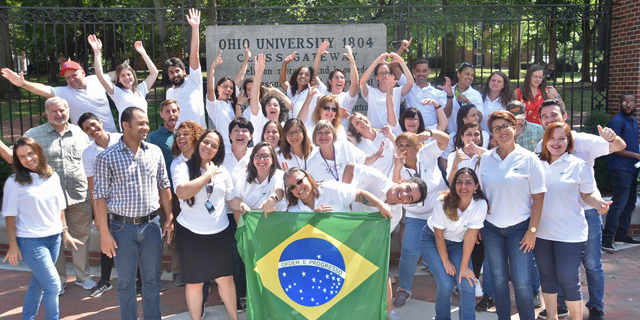A Second Life for Intensive English Programs
Five years ago—which, in international education, seems like yesterday and also like a lifetime ago—international student enrollment in intensive English programs (IEPs) was at an all-time high. In February 2015, more than 105,000 international students were enrolled in an IEP in the United States. By February 2020, that number had dropped by about 45 percent to approximately 58,000 students, according to data from the Student and Exchange Visitor Information System (SEVIS).
IEPs are often seen as a foreshadow of things to come in the international education industry; they are typically the first programs on most U.S. campuses to feel the impact of ebbs and flows in international enrollment. Educators say that IEPs have long weathered these ups and downs, and, recently, have pivoted their expertise and offerings in creative ways to stay afloat.
To offset potential enrollment and revenue declines, IEPs are pursuing new partnerships with institutions abroad, offering customized programs, and rethinking the role that they can play—and value proposition they have to offer—in higher education.
A Fundamental Shift
Scott Stevens, director of the English Language Institute at the University of Delaware, has been involved with teaching English as a second language (ESL) for more than 40 years. “It’s always been a wild ride for IEPs,” he says. “We’ve always had these huge rises and falls in market trends as different countries become leading countries in sending students and then sort of fall by the wayside.”
Over the course of his career, Stevens has seen markets such as China, Iran, Japan, Korea, Malaysia, and Saudi Arabia jockey for position as the top country sending students to study English in the United States. However, the pressing question among language professionals is whether or not the most recent enrollment decline is just another fluctuation—or if it is evidence of a more systemic shift within international education.
“The general consensus is that this downturn is qualitatively different from what we’ve experienced in the past,” says Mark Algren, program instructor and executive director of the Center for English Language Learning at the University of Missouri. “In the past, we’ve been able to peg the downturn to a particular historical event.”
Algren points to events such as the Asian financial crisis in the late 1990s as a precipitating event for the ebb of Japanese and Korean students. Another example is September 11, 2001, when new student enrollments from Middle Eastern countries subsided. The recent loss of government-funded scholarships in countries like Brazil and Saudi Arabia, which contributed to the record numbers of IEP enrollments, have also helped explain past downward trends.
Perception and Reality
There are multiple reasons behind the present decline, says Algren. Starting in the early 2000s, more countries began teaching English to children at an earlier age, so students now leave secondary school with stronger English skills. Additionally, the U.S. dollar is currently strong, making higher education in the United States a more expensive prospect. Many surveys also show that families do not perceive the United States as a safe place to study.
The perception of increased visa denials has further discouraged some students from applying, says Jennifer Phillips, director of the Wisconsin ESL Institute (WESLI), a private language school in Madison, Wisconsin. While they haven’t seen an actual uptick in denials for students who applied, students who have enrolled in language programs in other countries, such as Canada, have said they didn’t want to risk a visa denial.
“We’re not seeing [as many] students who go through an entire intensive English program from start to finish in 1 or 2 years. We’re seeing more customized classes and programs that are connecting English language study to a professional or academic field.” —Cheryl Delk Le Good
In addition, students’ expectations have shifted over time. “What’s different now is that the students have changed their demands,” says Cheryl Delk Le Good, executive director of EnglishUSA.
“You’re not looking at the same type of students from 20 years ago, even 10 years ago,” she says. “We’re not seeing [as many] students who go through an entire intensive English program from start to finish in 1 or 2 years. We’re seeing more customized classes and programs that are connecting English language study to a professional or academic field.”
Stevens says that while the current decline represents a more fundamental change that is informed by all of these factors, IEPs are well positioned to respond because of their historical experience with volatile markets.
“Because of these shifts, IEPs have grown to become more nimble and more entrepreneurial,” he says.
Demand for Customized Programming
These two characteristics will help determine the future of IEPs on campuses across the United States. With the decline in enrollment, there is a decline in revenue—and institutions are adopting different approaches to position their expertise and offerings in new ways to fill the gap.
Delk Le Good says one of the ways that IEPs are responding is by providing more short-term, customized programming. Customized programming isn’t new, she says, but “it’s in overdrive right now.”
“[Students] are learning lower- or intermediate-level English in their own countries or online, and then they come over and want to jump right into a content area,” she says.
Recently, Delk Le Good received an inquiry from Brazil looking for English courses with a focus on agribusiness. The prospective client also wanted a homestay on a farm. “There’s increased demand for this boutique kind of programming that IEPs have always been pretty flexible in putting together,” says Delk Le Good.
“You have to be offering something, some content or skill building, in addition to the English instruction.” —Gerard Krzic
Gerard Krzic, director of Ohio Program of Intensive English at Ohio University, agrees and says that his faculty are used to adapting their teaching to the needs of specific partners. As a result, they are able to offer their expertise in working with non-native English speakers to help other academic units tailor their content for students who are still learning the language.
“You have to be offering something, some content or skill building, in addition to the English instruction,” he says.
For example, at the Intensive English Language Institute (IELI) at Creighton University in Nebraska, an IELI faculty member teaches a fall semester class that she specifically created for cohorts of Chinese and Korean students who come for a master’s program in occupational therapy and rehab.
“These students meet the minimum English proficiency needed for their master’s program, but the class further supports the academic English writing and presentation skills needed for their program,” says director Jill Fox.
Increased Collaboration and Partnerships
Creighton’s IELI also relies on its partnerships across campus, the key to which is “making connections and maintaining communications,” says Fox. “We have increased our efforts to be more involved and active around campus, so more faculty, staff, and students know who we are, what we do, and what we can do.”
The fruits of these efforts include a lunch and learn event on campus that resulted in new connections, inclusion in the new faculty orientation to familiarize newcomers with the IEP from day one, and the revival of a discontinued workforce English program for facilities staff, created in partnership with the campus facilities department.
While many institutions have always offered courses in business English or a pre-MBA program, there has been increased cooperation with other academic disciplines and departments such as engineering, nursing, medicine, and law. For example, the IELI partnered with Creighton’s School of Pharmacy and Health Professions on a summer program it hosts each year to bring students from China. The program incorporates some English language and American culture classes into the otherwise health-focused curriculum.
Such collaborations can resonate across campus. “The College of Dentistry heard from someone in the pharmacy department about the support our office was providing to some students” and followed up with Fox’s office, she says.
Many IEPs also partner with their institution’s continuing education departments. In addition to its intensive English courses, University of California-Irvine, for instance, offers three-month postgraduate accelerated certificate programs for international students in fields such as the business of e-sports and strategic communication management.
Regardless of the academic focus, IEPs can build bridges across the institution. At the University of Delaware, whenever a new leader is appointed on campus, including department chairs, Stevens extends an invitation to visit the international office for a half-hour “ELI 101” presentation and discussion. “This often leads to generating ideas on how to collaborate,” he says.
“Know the capabilities of potential partners—and whether they have all that they can handle or are looking for new areas in which to expand.” —Scott Stevens
Leveraging relationships with existing advocates on campus can be a good place to start. “Rekindle that association and meet to discuss opportunities you might explore together,” says Stevens. “Having invested in this relationship and [feeling] confident you are dealing with a real supporter, it is easier to get out of the starting block.”
He also recommends that IEPs take inventory of strengths and capacities across campus, including identifying potential new partners for collaboration. “Do your homework,” he says. “Know the capabilities of potential partners—and whether they have all that they can handle or are looking for new areas in which to expand. Armed with information and ideas, schedule a meeting to suggest possible areas of collaboration.”
Developing international partnerships has also been a successful strategy for IEPs. Krzic’s staff began offering more of what he calls “English Plus” programs, during which international students come to Ohio University’s campus for language training with a specific academic focus. For example, working through the College of Communication, they host a group of students from Japan's Chubu University twice a year for a semester of English courses, service learning, and academic classes. They also collaborate with the College of Business to offer two-week modules for business professionals from Brazil.
Creighton’s IELI program has also turned to new partnerships and short-term programs to help offset its enrollment decline. The institute now takes part in bilateral exchange programs, such as a partnership with a Jesuit university in Japan.
“While these don’t generally bring more direct revenue to our budget, these agreements allow Creighton study abroad students to go to that partner university in Japan, and [conversely, for international students, it] includes the IELI as part of the larger university study abroad system,” says Fox. “The additional students to the IELI make the classrooms a richer environment and enhance the overall experience of all IELI students.”
Support for Local Populations
Many institutions are leveraging their English language expertise to serve a different population: those outside of campus. Whether these new students are refugees who have been resettled in the area, executives from multinational corporations relocated to the company’s U.S. headquarters, or local high school students, educators are pivoting to meet the needs of their communities.
At Kirkwood Community College in Iowa, the English Language Acquisition (ELA) program teaches English to more than 600 students. While some students are on F-1 visas, the majority are immigrants and refugees who live in Cedar Rapids.
“We have a five-level English course sequence…that prepares students for college-level coursework or whatever certificate coursework they want to take at Kirkwood,” says instructor Betsy Baertlein. “All of our students have some sort of academic goal when they come to us.”
English professor Catherine Schaff-Stump stresses that the program is not an IEP; most students are only able to study part time while they work full time. “We are not designed to attract students here to study from abroad,” she says. “We are designed to help students who are already here.”
Baertlein adds that the ELA program has maintained its enrollment while her colleagues at other institutions have reported significant declines, which in many cases means faculty layoffs.
Stevens, at the University of Delaware, also sees a major role for IEPs to play in light of changing demographics in the United States. He points to the increasing number of immigrant and refugee students, students who don’t speak English as their first language at home, and international students who attend high school in the United States.
“Many of these students may adapt socially, but they often don’t develop really strong academic reading and writing skills,” Stevens explains. “It becomes incumbent upon universities to be able to support [them]”—which might start before students even enter college.
IEPs might enroll local students directly, or provide training for the K–12 teachers who are increasingly working with ESL students. At the University of Delaware’s English Language Institute, local educators can take a series of five courses to earn an additional teaching endorsement in ESL.
“There’s a role for universities [through IEPs] to partner with public schools that are dealing with this huge glacial shift in the demographics and do not have the resources to fully address the linguistic and cultural needs of these students,” Stevens says.
Miami University hosts an English Language Center at its regional campus in Middletown, Ohio, located about 20 miles from the main campus in Oxford, that serves approximately 250 students per year. Many students who complete the IEP later enroll at Miami as degree-seeking students. The English Language Center also offers an eight-week summer program for around 75 English language learners from local high schools; the high school students take classes alongside international students.
“Their ESL directors have reported that they’re more motivated and performing better. And now we’re seeing them enroll at [Miami’s] regional campuses.” —Jerry Martin
Butler County, where Middletown is located, has seen an explosion of students who do not have English as their first language, according to center director Jerry Martin. Concurrently, there has been a decrease in the domestic school-age population. The English Language Center not only supports local high schools, but it also serves as a recruitment strategy.
“We have seen those students become better prepared when they go back into the high school” after the summer program, Martin says. “Their ESL directors have reported that they’re more motivated and performing better. And now we’re seeing them enroll at [Miami’s] regional campuses.”
Expanded Enrollment Opportunities
Another tack many IEPs are taking is to expand when, and how, international students can enroll in courses. For example, WESLI now offers 12 official start dates throughout the year, though Phillips says that students can start any time they want. “We have seen an increase in applications because of this. People have specific time frames when they can travel,” she says.
This model requires more intensive advising with each student. “All of this flexibility that we are doing to try and bring in students to keep the school afloat puts a much higher demand on our student services and administrative staff,” she says. Her staff joke that they have half as many students who take twice the amount of work—a common sentiment among IEP faculty and staff.
Alternatively, many institutions are turning to online opportunities to expand their reach, says Algren at the University of Missouri. Some programs provide English language support to students before or after they travel for a short-term program, while others are fully online.
Kirkwood, for instance, has been able to repurpose its distance learning technology to teach ELA courses to high school students in Brazil by using the same online platform it uses to offer dual enrollment classes to Iowa high schoolers. Kirkwood ELA instructors have been offering online English courses to Brazilian high school students for the last 7 years.
“There’s no difference between us communicating between here and Chicago or here and Brazil,” says Todd Prusha, executive dean of distance learning. “It’s been a great partnership.”
Resourcefulness and Reinvention
Though IEPs are often the first programs to feel the pinch as the international education landscape evolves, by pursuing new partnerships, thinking creatively about how to reposition their expertise, and offering customized programs that adapt to changing needs, programs are staking claim to new corners of English language learning.
“We know this is a challenging time, [but] we’ve had them before,” says Algren, who is optimistic that IEPs will weather the current storm. “There’s still a need for learning about academic culture, academic language, and how we present information in an academic setting. I think there’s always going to be a need for IEPs, but it will require shapeshifting a little bit.” •
About International Educator
International Educator is NAFSA’s flagship publication and has been published continually since 1990. As a record of the association and the field of international education, IE includes articles on a variety of topics, trends, and issues facing NAFSA members and their work.
From in-depth features to interviews with thought leaders and columns tailored to NAFSA’s knowledge communities, IE provides must-read context and analysis to those working around the globe to advance international education and exchange.
About NAFSA
NAFSA: Association of International Educators is the world's largest nonprofit association dedicated to international education and exchange. NAFSA serves the needs of more than 10,000 members and international educators worldwide at more than 3,500 institutions, in over 150 countries.
NAFSA membership provides you with unmatched access to best-in-class programs, critical updates, and resources to professionalize your practice. Members gain unrivaled opportunities to partner with experienced international education leaders.















